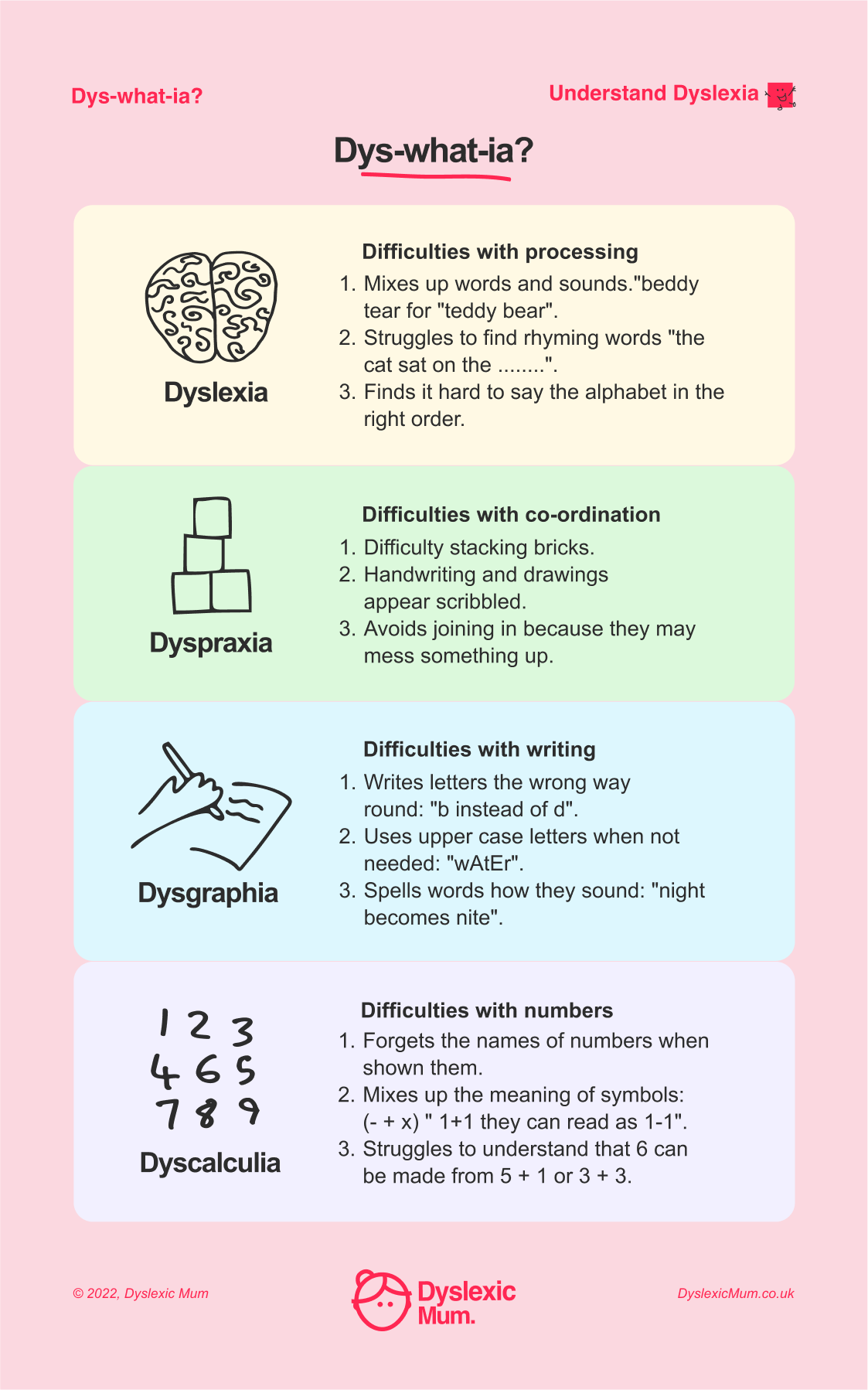Your basket is currently empty!
Learn the different types of dyslexia. Find out the difference between dyslexia, dyspraxia, dysgraphia and dyscalculia. Read below a simple explanation for each of the similar neurodiversities.
- Dyslexia – Information processing issue: Child finds it hard to remember the alphabet and word spellings. Mixes up sounds in words, says “Beddy Bear”, for “Teddy Bear”.
- Dyspraxia – Movement is an issue: A child may struggle to stack bricks, has messy handwriting and appears to be clumsy.
- Dysgraphia – Struggles with writing: Writes letters wrong way round, randomly misspells words, mixes-up lower and upper-case letters.
- Dyscalculia – Numbers related difficulties: Struggles to recognise numbers, do simple maths sums and remember times-tables.
Dys-what-ia? Card
To explain the difference between similar learning difficulties to a child use the “Dys-what-ia?” card below. These Mooki Cards are based on scientific research. Learn more, “Neurodiversity and co-occurring difficulties”.


Different types of dyslexia
Learn below about how the Dyslexia Mum struggled to understand the different types of dyslexia:
“When I first started to notice that my child had the signs of dyslexia, I spoke to other parents. They would say, “that sounds like my sister, she has dyspraxia”. Or “have you thought maybe she has dysgraphia?”. This left me feeling overwhelmed and confused.
What I needed was easy to understand examples of the differences between dyslexia and the other learning difficulties. To learn the main signs, symptoms and treatments for these learning difficulties. So I made the card above to help myself and others.”
Watch clickable video below where the Dyslexic Mum explains the differences between neuro-diversities that are similar to dyslexia.
Can a child have both dyslexia, dysgraphia, dyscalculia and dyspraxia?
Yes a child can have dyslexia, along with dysgraphia, dyscalculia and dyspraxia. They are all learning difficulties, caused by a brain processing issue.
A child may have just one or a mix of these neurodiversities. To also have ADHD is very common amongst neurodiverse children. Research has show:
- 53% of dyslexic children are likely to also have dyspraxia.
- 10% of children have dyslexia and dysgraphia, dyscalculia or dyspraxia.
- 20%-40% of dyslexic children also have ADHD.
Difference between dyslexia and learning difficulties
There are many learning difficulties similar to dyslexia, such as dyspraxia, dyscalculia and dysgraphia. It can be difficult to understand the difference between them.
Children with dyslexia, dyspraxia, dyscalculia and dysgraphia. All struggle to process information, learn new things and interact with the world around them.
All these learning difficulties are recognised as a disability in the UK. Legally schools have to provide extra support and make changes to the way they teach to help these children.
Dyspraxia what is it?
Dyspraxia mainly affects a child’s movement and their fine motor skills. For example being able to thread beads onto a string.
Dyspraxia is a learning difficulty and cause also make it hard for the child to get organised and focus on tasks. Dyspraxia mainly affects:
- Movement
- Gross Motor Skills
- Speech
- Organisation
- Concentration
- Social Skills
Dyspraxia spot signs checklist
Learn more about the differences between dyslexia and dyspraxia below. What the common symptons of dyspraxia are:
- Body Movements – Struggles to move with coordination, may have been slow to crawl and learn to walk. The child may find it harder to play sports, catch balls, run and hop. They may be prone to tripping and falling.
- Small Movements – Finds it hard to do fiddly, smaller tasks. To grip pencil, write letters, numbers. Struggles to tie show laces, fasten buttons and use cutlery. Child may need to be shown how to do these things, rather than learning alone.
- Organisation – Difficulties in remembering sequences. Such as days of the week, months in the correct order. May struggle with time management, planning tasks and remembering important dates.
- Concentration – Finds it hard to focus, gets easily distracted, fidget and may have ADHD type behaviour.
- Communication – The child’s speech may-be affected. They may use very basic words for their age and struggle to say longer words. When they speak, they can muddle up their words and find it hard to say what they mean.
Dysgraphia what is it?
Dyspraphia mainly affects a child’s writing ability. For example being able to form letters correctly, when writing.
Dysgraphia is a learning difficulty and is caused by a brain processing issue. Dysgraphia mainly affects:
- Holding pen/pencil
- Writing letters/numbers
- Spelling
- Grammar
- Putting ideas in writing
Dysgraphia spot signs checklist
Learn more about the differences between dyslexia and dysgraphia below. What the common symptoms of dysgraphia are:
- Gripping pens/pencil – Child finds it hard to hold pen correctly and controlling it when writing.
- Forming letters/numbers – Unable to correctly write letters and words. They may be written in reverse and unevenly spaced. This may make their writing harder for someone to read.
- Spelling – Finds it hard remember correct spellings and get letters in the correct order.
- Grammar – Confuse capital and lowercase letters. Struggles to use full stops and commas correctly. Many miss out words in sentences and put words in the wrong order.
- Slow at writing – The child’s writing speed is slow, as they have to think about every letter and word they write.
Dyscalulia what is it?
Dyscalulia mainly affects a child’s maths and numbers ability. For example being able to, add and subtract numbers easily.
Dyscalulia is a learning difficulty, that is also linked to memory issues. Dyscalulia mainly affects the child’s ability too:
- Recognise Number
- Do basic maths sums
- Learn times-tables
- Tell the time (anolog clock)
- Understand 3D shapes
- Get organised
What causes dyslexia, dyscalculia, dyspraxia and dysgraphia?
Dyslexia, dyscalculia, dyspraxia and dysgraphia are due to a brain processing issue. Usually they are caused by genetics, something a child is born with.
- They are all learning difficulties that can affect a child’s ability to learn.
- The child will need extra support to help them learn.
- A neurodiverse child may struggle to write, move and do mathematical equations.
- Educational psychologists are able to assess if they have co-occurring difficulties during a formal dyslexia assessment.
Dyscalulia Spot Signs Checklist
Learn more about the differences between dyslexia and dyscalulia below. Understand what the common symptons of dyscalulia are:
- Understanding Numbers – The child may struggle to recognise numbers and maths symbols. They may find it had to break numbers down into smaller numbers. Such as (5 = 2 + 3)
- Maths Sums – Struggles with basic maths sums, such as adding and subtracting. Finds it hard to learn factions, decimal places and long division.
- Times-tables – Remembering maths facts and rules. Such as times-tables and equations.
- Learning the Time – Learning to tell the time on an anolog clock can be very challenging. As the child finds it hard to understand how hours are broken down into minutes and seconds.
- 3D Shapes – Lack of understand of 3D shapes and how they fit into spaces. The child may struggle to plan and build 3D model.
- Time Management – Issues will memory can affects a child ability to plan and manage time. They may also be very slow at completing maths tasks and struggle to complete Maths tests.
Dyslexia articles
To learn more about how neurodiversities affect children, see the blog post links below:
Designed to help dyslexic children Mooki Cards. Complete with 56 cards and storage wallet. Perfect for using at home or in the classroom. Order your Mooki Cards here!

